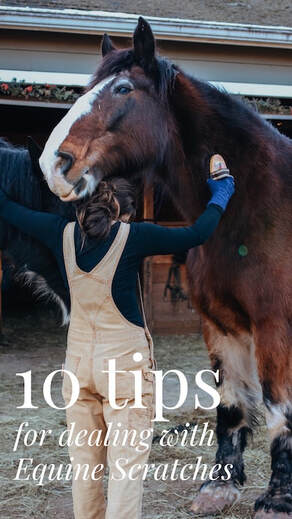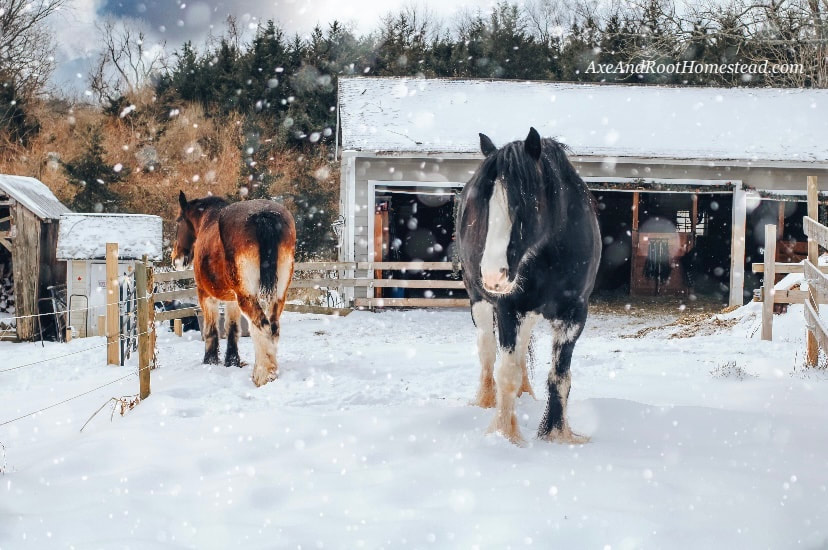|
Time Stamps: Sacrifice Plot 0:13 / Winter Pasture Management 1:44 / Pasture Division and Rotation 2:37 / Winter Seeding 4:21 / Sacrifice Rehabilitation 6:11 / Dry Lot 6:33 / Foggage 7:02
A well managed pasture is an integrated plan—a series of efforts working together to create a grazing space that doesn’t detract from Mother Nature through unnecessary carbon loss, tillage, compaction, and erosion. Rather, several initiatives can be implemented to maintain the integrity of pasture spaces year-round without sacrificing quality of life and forage on the part of the animal. In this video I’m sharing the several different efforts I make to keep four draft horses, five sheep, and a flock of ducks and geese thriving on my six-acre farm without ruining my land. Through winter pasture management, implementing dry and sacrifice plots, winter seeding, foggage or standing hay growth, and proper pasture division and rotation in the warmer months, we can continue to keep our animals healthy and happy while remaining ecologically sound. Several relevant content sources to support this video
Time stamps: On Finnegan: 0:15 // Meet the new horses: 1:00 // See the stable upgrade: 5:10
I have been putting off making this video because we recently endured a devastating loss on my permaculture farm; my partner and friend, Finnegan, passed away unexpectedly. While processing my grief, it was essential I find Dozer (my remaining Clydesdale mare) a stablemate because horses just don't do well alone. Very quickly, I found two beautiful horses we could offer a forever home to. Meet Sholto and Nevin, who are both already broke to ride and drive. In this video I'm sharing the new comers, talking about losing Finn, and showing the upgraded stable. A few amazing places to shop for a horse if you're open to adoption: Colby's Crew: https://colbyscrewrescue.org/ Horses Deserve a Second Chance: http://www.horsesdeserveasecondchance.com/ Group hugs after I groomed my horses and clipped Finnegan’s feathers (the long hair that grows around the hoof). Shaving is a last resort at my farm but I will do it if I need to. You see, bacteria, moisture, and mites get trapped in the hair especially during spring thaws and mud season. It becomes very itchy and irritating and, if left untreated, can even cause a horse to go lame from the pain (not to mention infection). To make it even trickier to battle, a treatment that works for one horse won’t necessarily work for another. Dozer does well on pig oil & sulfur applied weekly. She has no issues. But this actually irritates Finn further.
If your horse has Clyde Itch/Mud Fever/ Scratches (it’s all the same) here are some things to try:
As always, with anything you apply be sure to do a patch test to make sure the horse has no allergic reaction. Additionally, keeping the horse away from mud and standing water is hugely helpful. I hope this helps! Feathered horse owners know this can be an ongoing battle to keep our babes comfortable. There is something magical about horses in the snow. However beautiful, the cold season increases the risk for colic in horses. The fluctuations in the cold cause horses to “forget” to drink as much water as they should (or not have access to it due to a frozen water trough). The lack or decreased intake of water slows motility in the gut and causes stomach upset—ranging from gas and bloating to serious complications like twisted intestines.
Dozer (my black mare in the front) almost died two years ago from a horrible colic episode... she had had previous episodes before I even brought her home. So now I do everything I can to keep these babes safe and healthy, especially since one horse is recurrent. Here’s my tips:
I'm happy to say that since implementing these practices we've managed to completely avoid colic cases thus far. I hope this information is helpful! |
Angela is the farmer and content creator behind Axe & Root Homestead® LLC. This historic six-acre permaculture farm is home to two Clydesdale horses, ten honeybee hives, five sheep, two guardian dogs, barn cats and a flock of 40 geese and ducks. The farm produces maple syrup, fruit from a small orchard and loads of garden produce for consumption, preservation and donation to the local food pantry.
The Sustainable Homestead is available NOW!
Categories
All
|





